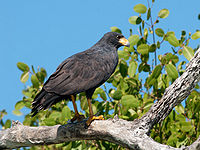Common Black Hawk
 From Conservapedia
From Conservapedia | Common Black Hawk | |
|---|---|

| |
| Scientific classification | |
| Kingdom Information | |
| Domain | Eukaryota |
| Kingdom | Animalia |
| Subkingdom | Bilateria |
| Branch | Deuterostomia |
| Phylum Information | |
| Phylum | Chordata |
| Sub-phylum | Vertebrata |
| Infraphylum | Gnathostomata |
| Class Information | |
| Superclass | Tetrapoda |
| Class | Aves |
| Sub-class | Neornithes |
| Infra-class | Neoaves |
| Order Information | |
| Order | Accipitriformes |
| Sub-order | Accipitres |
| Family Information | |
| Superfamily | Accipitroidea |
| Family | Accipitridae |
| Sub-family | Buteoninae |
| Genus Information | |
| Genus | Buteogallus |
| Species Information | |
| Species | B. anthracinus |
| Population statistics | |
| Population | 2,000,000+ (2016 est.)[1] |
| Conservation status | Least concern[2] |
The common black hawk (Buteogallus anthracinus) is a species of bird of prey of the family Accipitridae, and found primarily in the coastal areas of southern North America to northern South America.
Contents
- 1 Description
- 1.1 Subspecies
- 2 Range and habitat
- 3 References
Description[edit]
The common black hawk is a medium-sized, broad-winged raptor, about 17 to 21 inches in length, a wingspan of 41.7 to 50.4 inches, and weighs 27.9 to 42.3 ounces. Females are slightly larger than males. It is black or a deep fuscous brown in color, bearing a short, black tail with a single broad white band. The beak is black with a yellow cere, and the legs are yellow. Juveniles are dark brown above with a lightly-colored belly, and bear irregular dark spots or stripes throughout.
The call consists of a distinctive, shrill "speenk-speenk-spee-spee-spee", usually in sets of ten to fifteen[3].
Subspecies[edit]
- Buteogallus anthracinus anthracinus; southwestern United States to northern South America, St. Vincent and Trinidad
- Buteogallus anthracinus bangsi; Pacific coast of Costa Rica and Panama; Pearl Islands
- Buteogallus anthracinus rhizophorae; Pacific coast of El Salvador and Honduras
- Buteogallus anthracinus subtilis; Pacific coast of Colombia, Ecuador and extreme northern Peru
- Buteogallus anthracinus utilensis; Mexico (Cancún, Cozumel Island) and islands in Gulf of Honduras
Some authorities place B. a. bangzi, B. a. subtilis, and B. a. utilensis as subspecies of the mangrove black hawk, Buteogallus subtilis[4]; recent genetic testing has strengthened the position of the mangrove black hawk as a subspecies of B. anthracinus[5][6]. Once considered a sixth subspecies, the Cuban black hawk (Buteogallus gundlachii) has been declared a species in its own right[7].
Range and habitat[edit]
The common black hawk is found from northern Mexico southwards to Columbia, Venezuela, and the Guianas; they breed in a large area of central Mexico northwards into southern Arizona. They are primarily a coastal bird, preferring mud and salt flats, mangrove forests above high tide level, swamp or wet montane forests, and freshwater lakes, from sea level to 1,500 feet elevation.
References[edit]
- ↑ https://www.iucnredlist.org/species/22735514/113552417#population
- ↑ https://www.iucnredlist.org/species/22735514/113552417
- ↑ https://www.xeno-canto.org/species/Buteogallus-anthracinus
- ↑ http://www.globalraptors.org/grin/SpeciesExtended.asp?specID=8083&catID=2002
- ↑ http://www.museum.lsu.edu/~Remsen/SACCprop294.htm
- ↑ http://www.globalraptors.org/grin/researchers/uploads/155/manbhbullboc.pdf
- ↑ https://pdfs.semanticscholar.org/f326/da7e414c2808ce6221a64930a2d5f921e1cd.pdf
Categories: [Birds] [Birds of Prey] [Hawks]
↧ Download as ZWI file | Last modified: 02/28/2023 19:16:48 | 15 views
☰ Source: https://www.conservapedia.com/Common_black_hawk | License: CC BY-SA 3.0
 ZWI signed:
ZWI signed: KSF
KSF